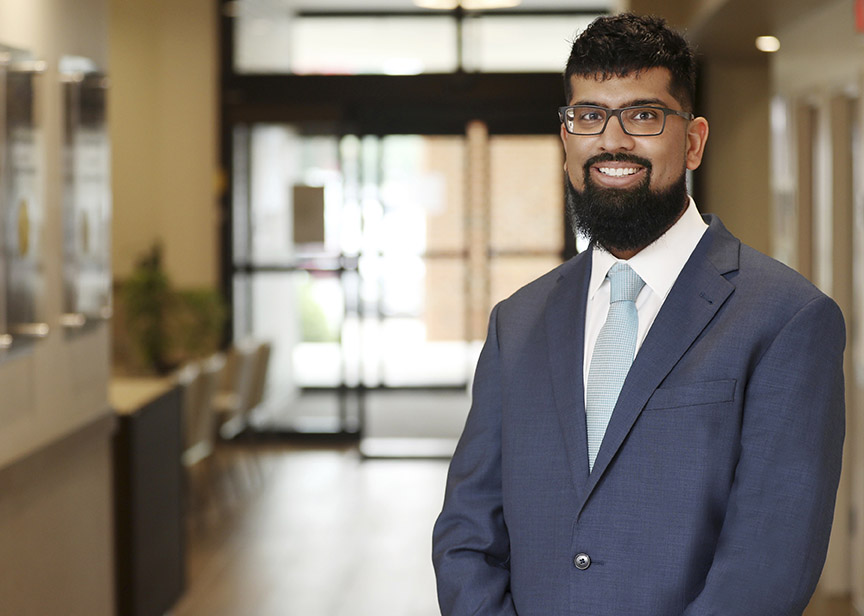
Vilok Vijayanagar, DO, is a board-certified and fellowship-trained general surgeon with TriCities Surgical Associates in Colonial Heights, Virginia, part of the HCA Virginia Physicians network and an affiliate of TriCities Hospital. He specializes in robotic and minimally invasive surgery and is an expert in the diagnosis and repair of umbilical hernias in children and adults.
What are the symptoms of an umbilical hernia?
An umbilical hernia occurs when fat or a small part of the intestine protrudes through a weakness in the abdominal wall, creating an obvious bulge or swelling near the belly button. Following inguinal hernias near the groin, umbilical hernias are the second most common type of hernia. They are most typically seen in children and adolescents but can affect adults, too.
In babies and young children, umbilical hernias are most evident when they are crying or coughing. Most umbilical hernias are painless, and the majority close completely by the age of five, without the need for surgical intervention.
What causes an umbilical hernia?
In babies, an umbilical hernia occurs when the abdominal muscles do not fully close around the location where the umbilical cord passed through during gestation. It is thought that up to 20 percent of babies are born with an umbilical hernia.
A risk factor is something that increases a person’s chance of developing a certain disease or condition. Risk factors for umbilical hernias in infants impact male and female babies equally, and include:
- Low birth weight
- Premature birth
In older adolescents and adults, umbilical hernias tend to affect females more than males. Umbilical hernias are more likely to accompany physiological conditions that increase pressure in the abdomen, such as:
- Obesity
- Prior abdominal surgery
- Strain from multiple pregnancies
- Strain from weightlifting
- Long-term dialysis to treat kidney failure
- Excess belly fluid, known as ascites
- Chronic cough
- Constipation
- Enlarged prostate
Over time, an umbilical hernia may grow in size as abdominal pressure increases.
When should a patient seek treatment?
If an umbilical hernia does not resolve in early childhood, it typically requires surgery. Delaying treatment may result in blood supply to the protruding intestine being cut off, a phenomenon known as strangulation. When strangulation occurs, emergency surgery is necessary.
Infants and young children
Dr. Vijayanagar encourages parents to seek immediate care if their baby or young child experiences:
- Vomiting
- Pain
- Discoloration or swelling near the hernia site
Older adolescents and adults
Likewise, signs that an older adolescent or adult should seek prompt emergency care for their umbilical hernia include:
- Increasing tenderness or pain near the hernia
- Bruising
- Nausea or vomiting
- Inability to pass gas
In addition to a physical examination of the umbilical hernia, Dr. Vijayanagar may order an x-ray, MRI, or CT scan to help determine the degree of strangulation and necessary treatment.
What treatment options are available for umbilical hernias?
Many pediatric hernias resolve themselves by the age of five, without needing medical treatment. For larger hernias, treatment options depend on whether the umbilical hernia is reducible, meaning it can be pushed back into the abdominal cavity, or if it is strangulated. Dr. Vijayanagar will consider the patient’s age, medical history, and a physical examination of the umbilical hernia to determine the recommended course of action.
Umbilical hernia repair surgery is a safe, routine procedure that usually is performed on an outpatient basis. Open surgery may be used for small hernias and minimally invasive, laparoscopic surgery may be used for recurring or larger umbilical hernias. Patients needing surgery are placed under general anesthesia and a small incision is made near the belly button. Small umbilical hernias are pushed back into the abdominal cavity and closed using sutures. For larger hernial openings, a piece of surgical mesh may be used in addition to sutures to help strengthen the weakened area of the abdominal wall. The procedure takes about 30 minutes to an hour.
Following surgery, patients are given prescription pain medication as needed and should avoid heavy lifting for two to four weeks.
Dr. Vijayanagar provides expert care for all types of hernia, and TriCities Surgical Associates often offers same-day and next-day appointment availability.
To schedule a consultation with Dr. Vijayanagar, book an appointment online or call (804) 524-2294